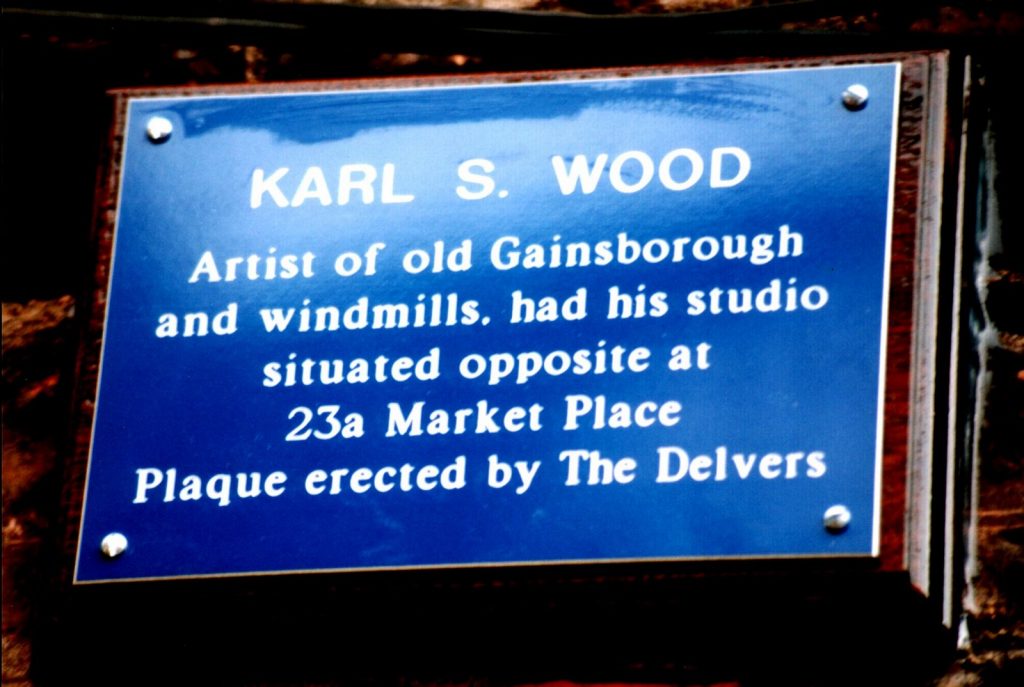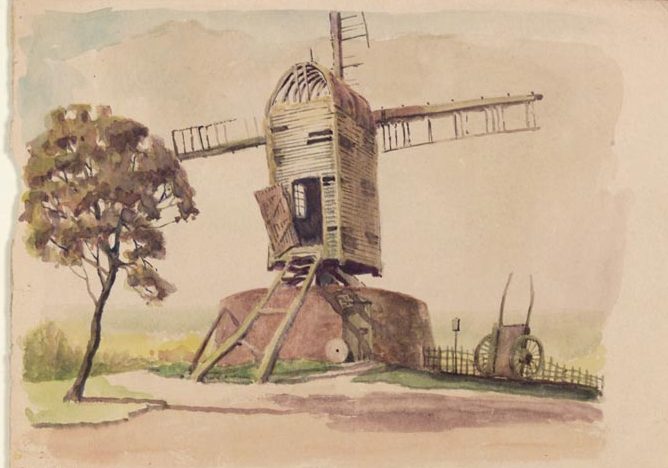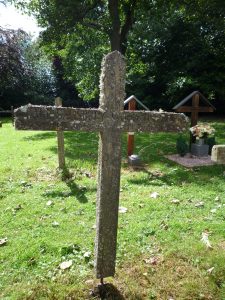Outside the town of Gainsborough Karl Salsbury Wood is best known for his Windmill paintings a superb record of industrial archaeology which is now a work for historical researchers around the country.
Karl S Wood was pretty much obssessed with windmills and set himself the momentous task of painting all of those that remained in the country (complete or ruinous), which, at the time he estimated at being around 1650. No mean feat when you consider that he travelled much of the country on his trusty bicycle, carrying with him everything he required for his expeditions.
Although not actually a local man he had made the town his home for a great many years and actually had relatives from the area, his Grandfather Timothy Wood being born in Blyton in 1827.
His youngest son John Radford Wood, a gardener at Kings Newton in Derbyshire married Harriet Salsbury from the same village where they setup home. It was here that on the 21st August 1888 Karl Salsbury Wood was born.
During his youth he had many interests and loved nothing better than conversing on subjects such as literature, art and music. At the age of 14 he and his family moved to Nottingham where Karl worked as a packer for a net lace manufacturer Louis Oram Trivett.
By late 1914 he had joined the Third Seaforth Highlanders where he became a Lance Corporal and it was during active service in France that he sustained a shrapnel injury to his ankle which for the rest of his life casued him to walk with a slight limp.

Blue plaque erected close to Karl’s Studio
Wood first came to Gainsborough in 1919 and soon made it his home, it being the longest he ever stayed in any one place, and it was here his name would become synonymous with windmills. The majority of people that knew him or saw him cosidered him very much an eccentric and that his appearance was akin to the lovable rogue ‘Tink’ from the TV series Lovejoy.
Karl’s first studio in the town was at 22 Market Place were he gave art and music lessons as well as making fancy dress costumes that were available to hire. He later moved to 27a Market Place in the 1930s. By the end of the second war he was residing at 23a and 25a Market Place in which was housed a small printing press that both he and his business partner Laurence John Wormell produced lino-cut greetings cards.
Catholicsm was an important aspect of Karl’s life and and during his time at Gainsborough he was heavily involved at the church of St Thomas’s on Cross Street as both Choirmaster and Organist. He also painted a mural at the back of the Lady Altar as well as other areas of the church although none of it is believed to have survived to the present day.
He enjoyed teaching and would give private lessons from his studio in both music and art, also teaching at the Queen Elizabet Grammar School during the thirties and forties when it would have been on Cox’s Hill and we have a rare photograph of him sat with the other masters at the rear of the school. He gave up teaching here after the summer of 1948 as his studio had become too busy.
As we have mentioned at the beginning Wood was best know for his prolific work on paitning Britains windmills a project which he named the Mühlendämmerungs which is a name that comes from his love of Wagner and in particular ‘Götterdämmerung’ which means ‘Twilight of the Gods’. Karl’s name meaning ‘Twilight of the Mills’, being the title of the book he intended to write containing his paintings and accounts of the mills themselves.

The Roving Molly Mill, Hemswell
He painted his first windmill in 1928, a local windmill called ‘Roving Molly’ at Hemswell. In 1932 on the 16th September he wrote the first of what would become a series of articles for the Gainsborough & Isle of Axholme News. An extract of the article “The Twilight of the Mills – Gainsborough Artist’s Big Task” is printed below:-
‘Our contributor, Mr. K.S. Wood of the Studio Gainsborough, has set himself the task of painting pictures of all the windmills in the country, his only means of locomtion is a pedal cycle and recently he made a fortnight’s tour on his machine through eight counties, painting views of roadside mills. In this and future articles he tells of some of his experiences. The title of his article is that of a book on Windmills which Mr. Wood is writing.
The extraordinary interest of the public in windmills – from the use of which the modern science of engineering developed – has led to my being asked to give an account of my most recent trip on a pedal cycle in search of these fast-passing relics of the past. Why pedal cycle? so many ask. Why not a motor car? Chiefly, I will reply because I have learnt that unless one works for a thing, it is scarcely worth the having. Then the exercise keeps one fit, one sees the country, one can get to places impossible to the motorcycle or car; and several other reasons.
Well, it so happened that I set off at 6:30am the first day of the recent heat wave. To be at Newark just after 8 o’clock, attired for a cycling holiday (Shorts, and all that) observing most folk about to commence their day’s work, seemed as pleasant as the gradual slipping away of consciousness under an anaesthetic. From here my course lay along the Great North Road – the finest road in the British Isles. Between Long Bennington and Foston I met a “hiker” who was walking from London to York. He had started on Sunday, and was walking lame, and had apparently averaged 30 miles per day. What struck one, already was the greenness of the countryside. I have never seen such a green August – the trees seemed to be exactly as they were in June. Grantham by 9:30, over what I have seen described as the steepest gradient on the Great North Road, but which I believe to be excelled by the hill south of Grantham, over the G.N.R south of Grantham, over the G.N.R bridge. I rode the first, but could not manage the second. The country here is very charming. Colsterworth was my first objective, so I turned to the right just after the railway bridge, seven miles from Grantham, and painted my first subject. This was the remains of a well-built stone tower-mill, in which a horse was sheltering from the sun, now growing fierce. The other mill of the village has left no trace.’
The transport on which he took most of his journeys was by no means special, no gears, a basket at the front and a box at the rear for his brushes and equipment, it was even made famous appearing in one of the mill paintings.
Unfortunately, he never managed to complete his quest but he did manage to paint about 1,400 as well as many bridges, churches, inns and other subjects along the way.
Perhaps one of his best known works that isn’t a mill and certainly the best know in the town are the two painted murals, one of the riverside and the other of the Old Hall inside Cleveland House.
Following his court case and subsequent prison sentence the shame for him was too much and he couldn’t face returning to Gainsborough and so he moved with all his paintings and equipment to Pluscarden Abbey in Elgin, Scotland he continued to paint here and and eventually became on Oblete.
In 1957 he contracted tuberculosis and after months of illness he passed away on the 10th January 1958, he is buried at the Abbey with a small wooden cross as a marker.

Karl Wood marker at Pluscarden
In 1973 some of the paintings that had remained at the Priory were borrowed by J.S.English the towns head librarian and local historian for an exhibition in Richmond Park, following which 200 were purchased by the Civic Society.
Two years later 30 of the then framed paintings were displayed in the Old Hall and a scheme was launched to get another 150 framed. The public were asked to sponsor a picture for the cost of £5 (the cost of framing) and then were allowed to hang one in their homes for a year.
The scheme was successful and ran for many years with the pictures being recalled and loaned many times, the last time from the then new Gainsborough Heritage Centre in 1997. Following the closure of the Civic Society the paintings are now in the custody of the Gainsborough Heritage Centre at their new home on North Street.
The current exhibition their until the end of February is featuring some of this rarley seen collection and is even offering the chance to own one of five specially selected limited edition prints of Karl’s local work.
